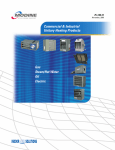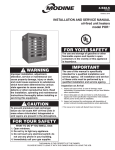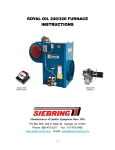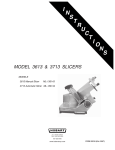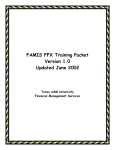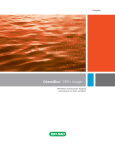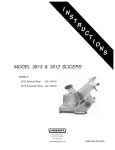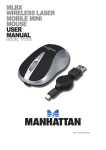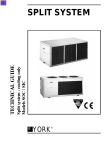Download Modine Manufacturing POR oil-fired unit Specifications
Transcript
4-112.3 September, 2008 Oil Fired Unit Heaters DESIGN FEATURES Maximum Performance, Comfort, and Efficiency Durable Attractive Casing Design Modine model POR oil-fired unit heaters offer an efficient and reliable means of heating, particularly in regions where supplies of other fuels, such as natural gas, may be unavailable, undependable, or interruptible. The units are direct driven propeller fan type units designed for overhead suspension and horizontal delivery of heated air. They are available in three model sizes: 100,000, 145,000, and 185,000 Btu/hr outputs. Time-tested and field-proven components are engineered into the design of these compact units which produce comfort heating at the lowest cost through their highly efficient operation. Models are UL-listed and require fuel oil grade No. 1 or 2, as specified by ASTM (American Society for Testing and Materials) D396-73 Standard Specifications for Fuel Oils or Canadian Government Specification Board, 3-GP-28. The casing is treated for protection against corrosion and painted with an attractive, Modine Gray-Green, baked polyester powdercoat paint finish. The following are standard features and benefits of the model POR unit (refer to Figure 2.1): Advanced Burner and Burner Controls Quiet, Efficient, and Safe Air Mover The propeller fan is statically balanced and the motor resiliently mounted to the finger-proof fan guard to minimize vibration and noise. Additionally, the draw-formed casing venturi at the air inlet is designed to reduce fan noise and power consumption. The motor is a totally enclosed, permanent split capacitor (PSC) type that provides excellent starting capabilities with low amp draw on operation. A fan and limit-control safety device performs three functions: 1) delays start of fan until the heat exchanger has warmed up and prevents fan from stopping until the heat exchanger has cooled, 2) protects the unit from overheating, and, 3) provides a manual switch for constant fan operation. The POR oil fired unit heater is equipped with the latest in Effective Heat Throw burner and burner control technology making the POR an Heat throw and coverage are controlled by manual adjustment industry leader in efficient fuel handling. Features include: of standard horizontal and/or optional vertical louver blades. • A pressure-atomizing, gun-type burner with a stainless steel, Depending on the model, the heat throw will vary from 39 to 51 die-stamped flame retention head that produces a highly feet, maximizing heated air distribution at floor level. stable flame with 20-30% greater combustion efficiency over non-flame retention type burners. The flame retention head Figure 2.1 - Model POR Unit Features matches the flame to the shape of the heat exchanger for maximum heat transfer while ensuring a long life. • A two-stage fuel unit for maintaining maximum fuel pressure delivery, even in high lift applications. Fan and Limit • The fuel unit utilizes an energy efficient permanent split Control capacitor (PSC) motor with ball bearings for reduced energy consumption, excellent starting characteristics, and reduced maintenance. Heat Exchanger • The latest in oil burner controls with a solid state Assembly microprocessor based controller featuring: (See Figure 3.1) > Interrupted-duty ignition that disables the spark ignition once the flame has been proven. This feature extends the Casing with life of the ignition system, reduces component noise, and Durable Baked saves energy over traditional controls that maintain a power Polyester Powdercoat Paint consuming spark during the entire call for heat period. > Limited recycle/limited reset feature to limit the accumulation Horizontal of unburned oil in the combustion area. Louvers > Communications port to enable communication with service instruments or data acquisition equipment. > Diagnostic LED to provide service personnel an easy indication of cad cell resistance and operational status (lockout, recycle, etc.). Flue Connection > 15 second valve-on delay provides a pre-purge mode that allows for clean starts and reduced maintenance. Propeller Fan > A cad-cell safety system de-energizes the burner controls with Finger-Proof Fan Guard if a flame is not produced in 30 seconds. Manual reset of flame protection is required following this safety shut-down. • Beckett electronic oil igniter module that provides superior Efficient PSC spark ignition (20kV peak) and a smaller and lighter package Fan Motor than older spark transformer designs. • Beckett CleanCut burner pump with the following advantages: > Cleaner operation by use of a solenoid valve that cuts oil flow almost instantly when power is cut to the motor, eliminating coasting stops that can cause soot formation on shut-down. Oil Burner with > Pre-purge type controls work hand-in-hand with the Microprocessor CleanCut pump to establish airflow and bring pump Control pressure up to full operating levels before light-off to ensure smooth and clean ignition. Junction Box > More reliable with fewer moving parts, compared to conventional pumps and fewer troublesome oil fittings to cause problems. 2 4-112.3 DESIGN FEATURES AND PERFORMANCE DATA Superior Heat Exchanger Life Expectancy Efficient Combustion Long life is due in part to the roll-formed design of the heat exchanger. Stresses caused by thermal expansion and contraction typically concentrate in areas of sharp angular bends or adjacent to welds, all of which are minimized with roll-forming to distribute thermal expansion stresses uniformly. Made of corrosion-resistant, 14 gauge aluminized steel, the heat exchanger contains a preformed, ceramic fiber fire pot that is thermally efficient, lightweight, resilient, and resists both mechanical and thermal shocks. It reaches operating temperature quickly, contributing to the efficiency of operation. Combustion products heat flow through the heat exchanger can be traced by the arrows in the cross-sectional view in Figure 3.2. Flue products rise to the top of the drum, then pass into the two radiators of the heat exchanger where internal baffles cause them to flow to the bottom of the radiators; then back up to the flue collector and out of the stack. During this passage the original temperature at the fire pot of 2200-2300° F, is reduced to a stack discharge temperature of 470 to 570° F. The units are designed to operate at a stack draft of minus 0.02” W.C. Easy Installation Figure 3.1 Model POR Heat Exchanger Features All units are factory-assembled, wired, and fire tested prior to shipment. Units are ready to connect to 115V/60Hz/1ph supply voltage, a 24V thermostat, fuel lines, and vents. Units are shipped for a single-unit two pipe oil supply system, but can be simply modified for a single pipe oil supply system or a multiple-unit installation supplied by a common fuel distribution system. They can be suspended with four threaded rods (1/2”13NC tap) or with 3/4” pipe by use of an optional pipe hanger kit accessory. Flue Connection Flue Collector Heat Exchanger Internal Baffles (not shown) Inspection Port Reduced Maintenance, Easy to Service Under average conditions Modine unit heaters typically require inspection only once a year, more often if the air is contaminated with fumes, dust, or spray. The heat exchanger is equipped with a convenient inspection port and the service door opening is ample in size to facilitate the removal of the fire pot should replacement become necessary. Two clean-out ports are also readily accessible for periodic cleaning. Refer to Figure 3.1. The motor is totally enclosed with permanently lubricated bearings to minimize maintenance. The fan and limit control, motors, and burner are externally mounted on the unit for easy service access. Service Door Clean-out Ports Ceramic Fiber Fire Pot (not shown) Application Suggestions For recommendations on specifying, applications, and locating unit heaters, refer to Modine Literature 75-203 “How to Specify the Right Unit Heater”. Figure 3.2 - Combustion Products Heat Flow Performance Data Model Input Btu/Hr Input Output GPH Btu/Hr POR100 119,000 0.85 100,000 POR145 175,000 1.25 145,000 POR185 231,000 1.65 185,000 CFM Delivery Temp. Max Heat @ 70°F FPM Rise °F Height* Throw 1890 2400 3200 460 580 740 49 56 54 12' 13.5' 12' 39' 50' 51' *Deflector blades pitched 45° at the floor (heated air). Mounting height is measured from floor to bottom of unit. Fan Motor Specifications Model HP Voltage Hz Phase Fan Motor Amps* POR100 POR145 POR185 1/5 1/3 1/3 115 115 115 60 60 60 1 1 1 2.1 5.4 5.4 RPM Type Fan Dia. 1100 1100 1100 PSC PSC PSC 18" 18" 22" *Total AMPS equals fan motor AMPS plus burner motor and ignition transformer load of 2.2 AMPS. 4-112.3 3 DIMENSIONS AND ACCESSORIES Figure 4.1 - Model POR Dimensions Table 4.1 - Dimensions (Inches) Model A B C D E F G H J POR100 POR145 POR185 27-1/2 27-1/2 28-5/8 35-1/4 35-1/4 40-1/4 28-1/8 28-1/8 32-3/4 25 25 26-1/8 23-7/8 23-7/8 23-7/8 13-3/4 13-3/4 14-3/8 8-5/8 8-5/8 8-5/8 23-7/8 23-7/8 25 8 9-1/2 10 K L M 12 38-1/8 16 12 38-1/8 16 13-3/4 42-3/4 20-3/4 Y Approx. Shipping Wt. (lbs) 8 8 8 324 333 398 Accessories Low-Voltage Thermostats – Single-stage, 24-volt. Thermostat Guard – Protects from damage or tampering. Booster Pump Relay – Used to control booster pump operation in the oil supply system. Factory set to close contacts at 50 PSIG with a maximum allowable pressure of 150 PSIG. Supplied with a 1/8” MPT connector and screw terminals. Oil Safety Valve – Protects the burner pump from excessive line pressure. The maximum inlet pressure is 60 PSIG. Vertical Louvers – Used in combination with standard horizontal louvers for complete control of air delivery. Draft Regulator – Barometric type with screw adjustments and hinge-pin action. Designed for precise control of drafts. Outside Combustion Air Kit – Kit converts the burner to accept outside combustion air piping. Includes adapter, gaskets, vacuum relief valve, outside intake air hood, and other miscellaneous hardware. Fuel Oil Filter – Protects oil burner from foreign particles. As Modine Manufacturing Company has a continuous product improvement program, it reserves the right to change design specifications without notice. Distributed By: Commercial Products Group Modine Manufacturing Company 1500 DeKoven Avenue Racine, Wisconsin 53403-2552 Phone: 1.800.828.4328 (HEAT) Fax: 1.800.204.6011 www.modine.com 4-112.3 © Modine Manufacturing Company 2008 Litho in USA 4-521.4 Part 5H70866A December, 2001 FIRE POT REPLACEMENT INSTRUCTIONS oil-fired unit heaters Fire Pot Replacement 1. Remove louvers by pushing each to the left against the coil spring and pulling out opposite end. 2. Remove access door by removing six (6) brass bolts at top and bottom of access door. Loosen the brass retaining nuts at the right and left edges and slide off the access door. 3. Remove all debris from heat exchanger drum to assure proper positioning of new fire pot. Remove door gasket and any remaining fragments from fire pot retaining clips. 4. From inside the drum, locate and drill two (2) .218 dia. holes 13" up from the bottom of the drum and approximately 2" from the old clip toward the front of the unit (one on each side). 5. Install new fire pot with the open end toward the burner tube (rear of unit). Fire pot must sit flat on bottom of drum. Fasten new fire pot retaining clips with stainless steel screws and nuts at previously drilled holes so clips retain fire pot corners. 6. Cut new door gaskets to proper length, add holes and install around door opening with tape or a suitable paste. Fasten access door at top and bottom with six (6) new brass bolts and then tighten brass retaining nuts along right and left edges. Tightening door in this sequence will assure proper sealing. 7. Reverse procedure in Step One to replace louvers. CAUTION: To prevent unusual thermal stress and eventual harm to the heat exchanger, do not operate unit heater without fire pot or with a damaged fire pot that does not enclose the flame. Louvers Retaining Clip Burner Tube Access Door and Gaskets Fire Pot Commercial HVAC&R Division • Modine Manufacturing Company • 604 Liberty Lane • West Kingston, RI 02892 Phone: 401.789.9388 • Fax: 401.792.9041 (Service & Parts) • www.modine.com © Modine Manufacturing Company 2001 12/01 - Litho in USA 4-530 5H080577A November, 2008 INSTALLATION INSTRUCTIONS CAS-2B Field Control AIRBOOT™ outside combustion air kit for model POR with Beckett Model AF burner WARNING Kit Components GASKET Fuel supply shall be shut-off and the electrical power disconnected before proceeding with the installation. Failure to do so could result in fire, explosion, electrical shock, or the unit starting suddenly resulting in injury. IMPORTANT 1. The use of this manual is specifically intended for a qualified installation and service agency. All installation and service of these kits must be performed by a qualified installation and service agency. 2. These instructions must also be used in conjunction with the Installation and Service manual originally shipped with the appliance being converted, in addition to any other accompanying component supplier literature. 3. This product is specifically designed for use with Beckett Model AF burners for ducting outside combustion air directly to the burner. AIR COUPLING MOUNTING SCREWS GASKET FLOW RESTRICTOR FIGURE 1 Model Application The outside combustion air kit for Model POR units is designed to provide a means of ducting combustion air to Modine Model POR units that feature the Beckett AF burner in applications where the supply of combustion air from the conditioned space is inadequate. Examples include tight buildings with inadequate makeup air or buildings with negative pressure. The combustion air would come from outside the space being conditioned. SK9551 VACUUM RELIEF INTAKE AIR (1) AIRBOOT™.................................................31988 (1) Burner Housing Gasket Set.........................31989 (2) Mounting Screws 1/4-20 x 1-1/4....................4226 (1) Extended Coupling.......................................21775 (1) Flow Restrictor.............................................31990* (1) 4" Vacuum Relief Valve (VRV)....................31991** (1) 4" Intake Air Hood (IAH)..............................31992** * Not used with Modine model POR units. ** These components MUST be installed in conjunction with the CAS-2B Field Control AIRBOOT™ to meet U/L requirements. THIS MANUAL IS THE PROPERTY OF THE OWNER. PLEASE BE SURE TO LEAVE IT WITH THE OWNER WHEN YOU LEAVE THE JOB. Modine Manufacturing Company has a continuous product improvement program, and therefore reserves the right to change design and specifications without notice. INSTALLATION – CAS-2B Field Control AIRBOOT™ Outside Combustion Air Kit Assembly/Installation Step 2. Assembly/Installation of the VRV The recommended procedure for assembly and installation is described as follows: Step 1 - AIRBOOT™ Installation Purpose of the Vacuum Relief Valve (VRV) The VRV is installed to provide a secondary opening for combustion air supply in the duct system. This is especially important in the event of damage or blockage to the Intake Air Hood. VRV Operation The VRV gate operates on changes in vacuum pressure generated between the intake and the oil burner. The VRV gate will remain closed during normal burner operation. During any abnormal operation created by blockage of the Intake Air Hood, duct pipe, or significant changes in external building pressures, an increased negative pressure on the intake of the burner causes a reduction in burner air flow. Under this condition, the VRV gate opens, stabilizing and maintaining proper air flow to the burner. The VRV gate closes again once the abnormal condition is corrected. A. Remove the fuel pump, air shutter, and air band from the burner housing. B. Remove the original shaft coupling (or inlet air shutoff if applicable; the inlet air shutoff cannot be used with the boot) and install the extended coupling, part #21775. C. Install both sealing gaskets to burner housing, part #31989. (Figure 1, Page 1). D. Position the AIRBOOT™ over the burner housing on the air intake side. E. Align the holes in the AIRBOOT™ with the holes in the housing. Guide the pump shaft into the extended coupling and secure the fuel pump with the 1/4-20 x 11/4 mounting screws (do NOT over tighten pump bolts) A. NOTE: The AIRBOOT™ may be oriented either vertically or horizontally as space allows (Figure 2). The round spacer ring attached to the AIRBOOT™ can be detached by removing the two (2) plastic fasteners, rotating the spacer plate 90° (from vertical mounting), and reinstalling the plastic fasteners. (Figure 3, Page 2) Mount VRV tee assembly or 90° elbow into the AIRBOOT™ intake. Fasten using three (3) sheet metal screws on all joints (Figure 4). OUTSIDE WALL INSTALLER SUPPLIED 4” PIPE INTAKE AIR HOOD ALTERNATE VRV LOCATION FIGURE 2 Horizontal Orientation SK9553 Vertical Orientation FIGURE 4 VRV LOCATION AIRBOOT ™ SK9554 PLASTIC FASTENERS B. Assemble VRV balance weight onto gate. Screw the weight all the way in, and then attach lock nut and knurled nut (Figure 5). BALANCE WEIGHT SPACER RING VRV ASSEMBLY FIGURE 3 GATE LOCK NUT SK9552 NOTE: If the fuel lines have been disconnected in order to remove the fuel unit, or if this is a new installation, the fuel unit may require bleeding before initial burner start-up (look under Burner Start-Up and Adjustment for bleeding procedures). 2 FIGURE 5 KNURLED NUT SK9556 C. Mount the VRV assembly into the tee and fasten with screw and nut in collar tabs. To ensure proper operation, check the gate for being plumb as well as being level across the pivot point (Figure 6). 4-530 INSTALLATION – CAS-2B Field Control AIRBOOT™ Outside Combustion Air Kit Step 7. Burner Start-Up and Adjustment HORIZONTAL Caution: DO NOT start the burner when excess oil has accumulated in the chamber, when the furnace or boiler is full of oil vapor, or when the combustion chamber is very hot. LEVEL ACROSS PIVOT POINTS A. DIAGONAL After the installation is complete, set the initial AIRBOOT™ air dial setting at 250° for POR100 and 145 or 260° for POR185, as summarized in Chart 1. Chart 1 – Approximate Air Dial Settings (See Notes) Setup Data Model Size 100 145 185 Head F4 F4 F12 Static Plate 3-3/8R 3-3/8R 2-3/4U G.P.H. 0.85 1.25 1.65 VERTICAL FIGURE 6 SK9555 Step 3. Intake Air Hood Location (Horizontal Ducting) Mount Intake Air Hood 12 inches above finish grade. If mounting on the side of a building prone to drifting snow, mount 12 inches above the snow line. Approx. AIRBOOT™ Air Dial Setting 250° 250° 260° Notes: 1. Chart based on 20 linear ft. of 4” duct, two 90° elbows, and an Air Intake Hood. 2. G.P.H. is the firing rate for that specific model size. 3. Air Dial Settings are INITIAL settings. Always use combustion test instruments for final adjustment settings. NOTE: For vertical or through-the-roof air ducting, use Field Star-Kap™ terminal model SK-4. Step 4. Installation of Intake Air Hood Cut a 4-1/4" diameter hole through the side wall of the building. B. Slide the Inlet Air Hood through the hole and fasten to wall with appropriate fasteners. Seal the edges of the mounting plate with silicone sealant or equivalent. C. Always mount with the Intake Air Hood opening pointing down. B. Step 5. Installation of Air Supply Duct D. A. C. A. Duct length calculation: Do not exceed a MAXIMUM of 34 total equivalent feet (20’ straight pipe + two 90° elbows at an equivalent straight pipe length of 7' per elbow). Multiply the number of elbows by 7 and subtract it from the total run length. Maximum linear footage will be less for flex duct. Consult flex duct manufacturer for equivalent lengths. B. Route the duct work from the VRV tee to the Intake Air Hood using a minimum amount of elbows. C. Secure and support the duct work for the design and weight of the material used to prevent physical damage and separation of joints. E. F. G. H. I. NOTE: For guidelines, refer to recognized national building codes or any applicable local codes. Perform the initial startup and adjustment procedure for model POR oil fired unit heater per the unit heater Installation & Service Manual. When the burner air supply and draft are properly adjusted, the over-fire (combustion chamber) draft will be -.02" W.C. Allow at least ten minutes for warm-up, or longer if the appliance is new, in order to burn-off the oil deposits on the heat exchanger and other surfaces. Perform a smoke test. Reduce or increase the AIRBOOT™ air dial until a TRACE OF SMOKE is obtained. This is a reference point only, DO NOT leave the air dial setting here. Measure the CO2 in the flue gas at the TRACE of smoke level. Open the air dial and add reserve air until the CO2 is lowered to 11.5% to 12.5%. Perform a smoke test again. The smoke paper should now be clean (zero smoke). After all final adjustments are made, tighten the lock screw on the AIRBOOT™ air dial. Start and stop the unit several times to ensure there are no significant rumbles or pulsations. Recheck the draft, smoke, and flue gas levels to verify nothing has changed. Inspection Required During Servicing/Annual Maintenance D. To reduce uncontrolled air leakage into the duct, tape all joints and seams using standard foil or duct tape. E. For cold climate conditions. To prevent sweating on the outside of the duct when operating in areas that have temperatures -10°F or below, insulate the duct work at least 10 feet from Intake Air Hood. 1. 2. 3. 4. Step 6. Exhaust Termination Installation For barometric damper and other exhaust system requirements, refer to the latest revision of Installation & Service Manual 4-522 (revision .4 or later). 5. 4-530 Check the Inlet Air Hood and air supply system for accumulation of any foreign material. Give special attention to the 1/4" mesh screen inside the Intake Air Hood. Thoroughly clean all material from the system. Note any damage to components and re-place with exact system components. Verify that the VRV is operating properly. Using combustion test instruments, verify that the operating smoke level is "zero smoke" following procedure outlined in Step 7 section. Securely tighten the lock screw on the AIRBOOT™ air dial after final testing or servicing. 3 Commercial Products Group • Modine Manufacturing Company • 1500 DeKoven Avenue • Racine, Wisconsin, USA 53403-2552 Phone: 1.800.828.4328 (HEAT) • www.modine.com © Modine Manufacturing Company 2008 4-530 11/08 Litho in USA









